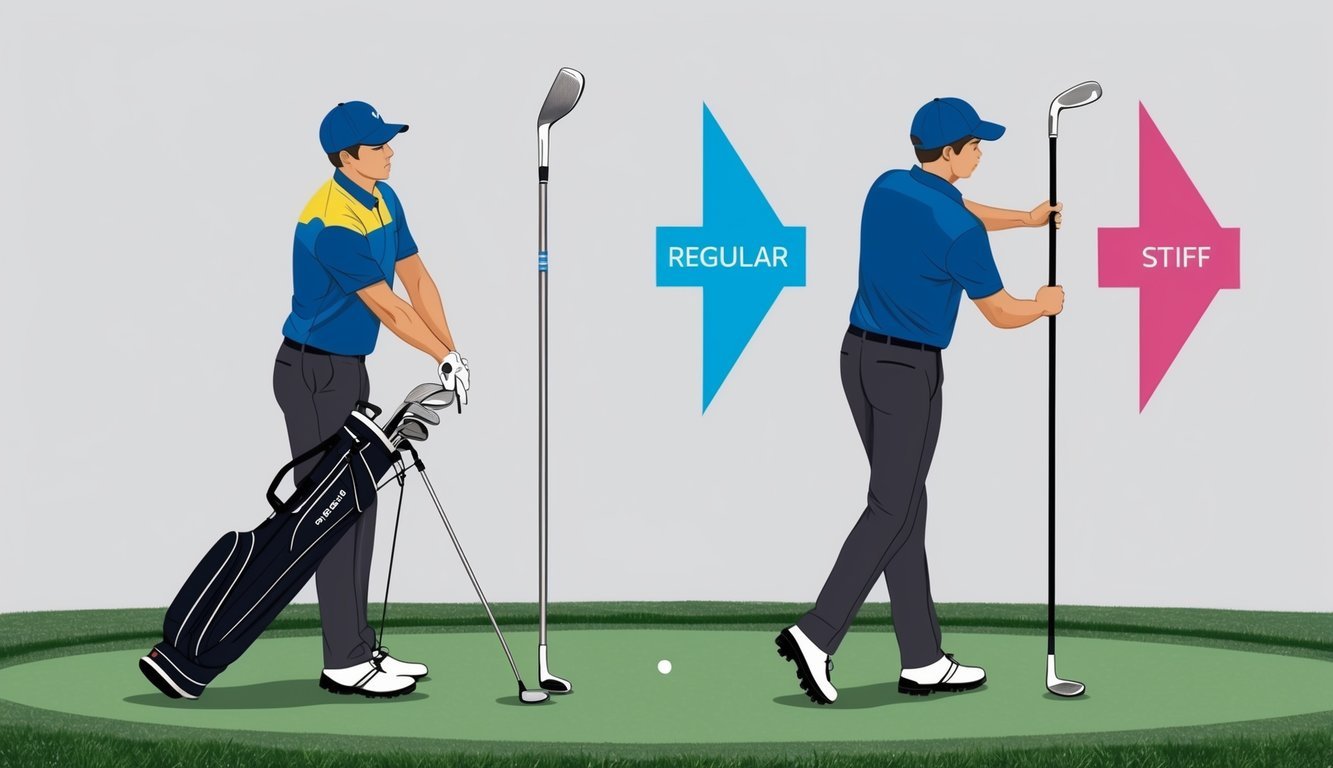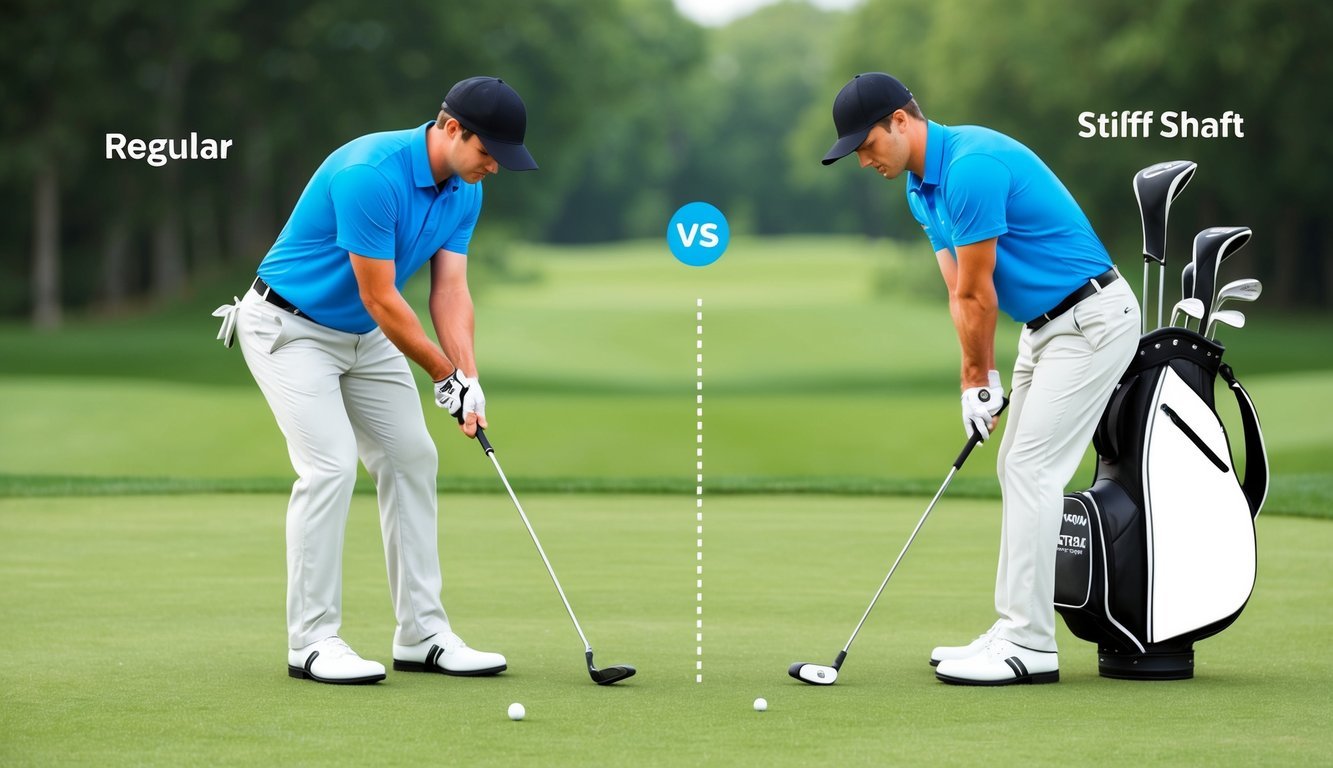Choosing between regular and stiff golf shafts can significantly impact your performance on the golf course.
Understanding the difference primarily hinges on your swing speed.
Regular shafts are typically suited for swing speeds of 84-96 MPH while stiff shafts are ideal for those in the range of 97-104 MPH.
This decision is crucial because the right shaft can enhance your distance and accuracy, allowing you to make the most of each swing.

When you’re deciding on the right shaft, consider how it affects your swing mechanics.
Regular shafts offer more flexibility, which could help slower swings achieve better distance.
In contrast, stiff shafts provide less flex and can help faster swing speeds maintain control and precision.
Selecting the wrong shaft could lead to decreased performance, so getting a proper fitting can be beneficial.
Engaging in custom fittings and avoiding common shaft-selection misconceptions ensures you tailor your equipment to your specific needs.
This personalization aids in maximizing your potential on the course and understanding how shaft flex influences your overall game.
Key Takeaways
- Shaft flex choice relies on swing speed.
- Regular shafts suit slower swings; stiff for faster swings.
- Custom fitting optimizes performance.
Understanding Shaft Flex and Its Importance in Golf
Shaft flex is a crucial aspect of your golf game, affecting swing speed and shot accuracy.
When selecting between a regular or stiff shaft, understanding how each influences your play can help improve your performance on the course.
The Role of Shaft Flex in Golf Swing
Shaft flex determines how much the shaft bends during your swing.
This bending impacts the trajectory and accuracy of your shots.
A properly matched flex aids in achieving optimal ball flight, consistent strikes, and improved distance.
Flex influences the timing and feel of your swing.
Too much flexibility can lead to less control, while minimal flex might cause a lack of distance.
It’s essential to balance these aspects considering your unique swing characteristics.
Swing speed plays a significant role.
Faster swings typically benefit from stiffer shafts, offering more control and precision.
Meanwhile, slower swings often fare better with more flexible shafts, which can add distance and help in better ball contact.
Shaft Flex Options: Regular vs Stiff
Choosing between regular and stiff shafts depends on your swing speed and personal preferences.
Regular shafts, with more flexibility, suit golfers with slower swing speeds, offering increased distance and better shot height.
They are typically ideal for beginners or those with a more relaxed swing tempo.
In contrast, stiff shafts cater to those with faster swing speeds, providing enhanced control and accuracy.
They reduce unwanted twists and help achieve straighter shots.
Players with strong, fast swings often find stiff shafts advantageous, ensuring stability throughout their swing.
Understanding the difference between these flex options is vital.
It’s not just about speed; it’s also about how you feel during your swing and your desired ball flight.
Testing both types can give you insights into what works best for your game.
Determining the Right Shaft for Your Swing

Choosing the appropriate golf shaft requires understanding your swing speed and how it relates to shaft flex.
Additionally, it’s essential to recognize how the shaft affects your swing dynamics, including distance and accuracy.
This will help you find the best match for your game.
Analyzing Swing Speed and Shaft Flex Relation
Your swing speed plays a vital role in determining the right shaft flex.
For a swing speed between 85 to 95 mph, a regular flex is usually ideal.
It provides a comfortable feel and a mix of control and flexibility.
If your speed is above 105 mph, a stiff or even X-stiff shaft might be more suitable.
These options offer more control by resisting excessive bending.
Assess your clubhead speed with tools like a launch monitor.
This allows you to make informed decisions about shaft selection.
Keep in mind that the wrong choice can affect your performance on the course, leading to inaccurate shots or reduced control.
The Impact of Golf Shaft on Swing, Distance, and Accuracy
The type of golf shaft significantly influences how you swing, how far the ball travels, and your shot precision.
A regular shaft can add a whip-like effect, benefiting those with slower swings by enhancing distance.
Meanwhile, a stiff shaft is better for those who require more direct control over their shots.
Experimenting with different shafts is crucial.
If you prioritize accuracy, the stiffness of the shaft can prevent unwanted flex that leads to misaligned shots. Light shafts can also aid in increasing swing speed, potentially boosting your overall performance.
Custom fitting at a golf club store can help identify the most comfortable shaft for you.
Technical Aspects of Golf Shafts
Choosing the right golf shaft involves understanding various technical elements.
Material differences, along with factors like weight, torque, and kick point, play a crucial role in performance.
Material Differences: Graphite vs Steel Shafts
Golf shafts come mainly in two materials: graphite and steel.
Graphite shafts are lighter, enhancing swing speed and providing additional distance, especially helpful for players with slower swing speeds.
They absorb vibrations better, offering a softer feel which can be beneficial for those with joint concerns.
Steel shafts, on the other hand, are heavier, offering more control and precision.
They are often preferred by players with faster swing speeds who can handle the added weight.
Steel generally provides a more consistent flex, making it suitable for those looking for accuracy over distance.
Weight, Torque, and Kick Point Explained
The weight of a shaft influences swing speed and control.
A lighter shaft aids in generating more swing speed, whereas a heavier shaft offers better control. Torque refers to the shaft’s resistance to twisting during a swing; lower torque equals less twisting, offering more control.
Kick point refers to the part of the shaft that bends the most.
A high kick point creates a lower, penetrating ball flight, while a low kick point produces a higher shot.
Understanding these aspects helps tailor your club to suit your playing style, enhancing performance on the course.
Personalizing Your Equipment Through Custom Fitting

In golf, custom fitting is crucial for optimizing your equipment to suit your unique swing.
It involves selecting the best shaft flex, weight, and club specifications to improve your performance.
How Custom Fitting Can Improve Your Game
Custom fitting enhances your performance by ensuring your equipment is tailored to your individual needs.
A professional club fitter assesses factors like swing speed, swing path, and ball flight.
By analyzing these elements, you get a set of golf clubs that match your technique.
Properly fitted clubs can help you achieve more consistency in your shots and reduce the risk of injury by minimizing stress on your body.
With tailored equipment, you can play more confidently.
Deciding Between Regular and Stiff Shafts in Fitting Session
During a fitting session, selecting between regular and stiff shafts depends on your swing speed and style.
Faster swingers typically benefit from a stiffer shaft, which offers greater shot control.
On the other hand, a regular shaft provides a whip-like motion conducive to slower swing speeds.
Club fitters will measure your swing dynamics to recommend an appropriate shaft.
They may also consider shaft weight and torque to fine-tune the clubs further, ensuring your equipment fully complements your playing style.
Common Mistakes and Misconceptions

Understanding the finer details of choosing between regular and stiff shaft flexes can significantly enhance your golfing experience.
Knowing the myths and how these shafts work for different player skill levels ensures better choices.
Myths About Shaft Flex and Performance
It’s common to hear misconceptions about shaft flex and its impact on your game.
One frequent myth is that a stiffer shaft guarantees more distance.
In reality, the flex you choose should match your swing speed and style.
A stiff shaft is suited for fast swing speeds and offers better control.
Another misconception is that regular shafts lack performance benefits.
While they are flexible, allowing additional whip-like motion, regular shafts can provide greater distance for those with moderate swing speeds.
It’s crucial to assess your own swing style and speed to select the right flex for optimal performance.
Choosing the Right Shaft for Beginners vs Professional Players
Understanding shaft flex is a key part of choosing a golf club for beginners.
Many new players assume they should start with a stiff shaft to align with professional standards.
However, regular shafts are often better suited for beginners due to their flexibility and ability to aid in longer shots with less effort.
Pros often benefit from stiff shafts due to their refined skills and faster swing speeds, offering improved control and stability.
Misjudging skill level and swing speed may lead to frustration and hinder improvement.
Carefully consider what best suits your current skill level as you develop.
This decision can significantly affect your overall performance on the course.

